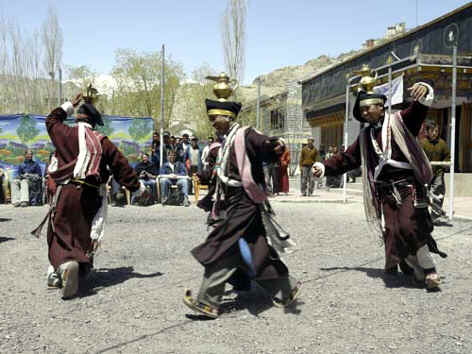Jigmet Palmo
Every region in India is rich in its art and culture and every culture has its own identity in terms of various symbols associated with the culture. Likewise, Ladakh in Jammu and Kashmir State is also a cultural goldmine. Ladakh is rich in various forms of dances and these dances have been passed from one generation to another. Ladakhi culture though influenced by western Tibetan traditions is also influenced by Islam and Brokpa community (the Dard r
ace).These dances are simple in thought, language and movement of steps. The movement and rhythm of steps starts from slow to fast which ultimately gives a complete harmony and satisfaction to the musician, performer and spectators too. A Ladakhi can watch these dances for an hour while sipping chang (local roasted barley beer). Traditionally Ladakhi society is divided into following castes Gyalrigs (royalty) Skutaks (nobility) Manrigs (commoners) and rigsnan (outcast).
Every folk dance of Ladakh begins with homage to three gems that is Buddha, Dharma and Sangha.These folk dances are followed by certain rules and regulations while performing a dance. The dancers make a queue in order of social status. Firstly, an aristocratic person leads the dance followed by commoners and then an outcaste person. Dances of Ladakh are seen best in their natural form at wedding place, festivals and during archery contests.
Variety of instruments are played but two musical instrument play a vital role : Daman and Surna. Daman, a pair of instruments made of copper in a bowl shape, and its open end is covered with an animal hide. Basically, it are drums of different sizes and there is a saying that one produces male sound and another female sound. These drums are played with two sticks.Next to Daman is a Surna, a long pipe like flute made up of a willow tree. The upper layer pierced with seven holes. These two instruments are almost popular in every region of Ladakh.Other instrument is a string instrument traditionally known as Piwang prepared from apricot wood and is popular among the Changthang community of Ladakh to lead their dance called Jab-bro.Daff and Dinjang are other two instruments being played in Ladakh. Daff is a round and thin drum, covered on one side with leather and other side provides musician a grip to hold it in one hand while other hand strikes the leather. Next to is Dinjang. It is covered on both the sides with leather and played with two sticks. These two instruments are made up of willow or walnut wood which are very expensive in Ladakh. These instrument were also handed over to the next generation in order to preserve the music as well as instrument itself.
Traditionally, 360 variants of dances existed in early times but in today’s time only few are preserved and are in vogue in Ladakh. These are as: male dances traditionally called Butse-tses and female dance known as pomey-tses. Next to it is Kompa Sum- tsag (the three step dance) Kathok chenmo(dance of nobility) celebrating the glory of Ladakh and the dynasty, Lhashon dance (dance of Gods and Goddesses) Chabskyan dance(beer or chang-pot dance) Mentok Stanmo (show of the flowers) Koshen dance(brocade dance)Takshon dance(aristocratic family dance)performed during new year, Shondol dance (breaking of line with backward steps) Chartses (bird dance) Nyewopa dance(marriage dance) jab-bro dance (Tibetan or nomadic dance) brokpa dance(Aryan dance ,another race in Ladakh) spawo dance (sword dance) Tashispa dance (dance of jubilation)
These dances reflect three stages. First starts slowly with a salutation with one round, in second stageof dance the rhythm and movement of dance step becomes little faster than the previous one and the last stage ends without salutation and these dances go for almost 15-30 minutes.
In dances like male and female dance, three step dance etc are performed in absence of song, it is an instrumental dance which include steps of body movement, hand gesture, slow steps of foot and these dance reflect the skill, confidence and spirit of the dancer to dance. Each dance is performed with different complicated style especially Chabskyan dance in which dancers carrying changpot on their head and these kind of dances needs a lot of practice and concentration.
Almost in every dance the brocade gown traditionally known as Koshen Goncha is carried by both male and female. Male also carry long scarves on their shoulder whileas female wear a woollen shawl traditionally called as Logor or Bok.
With the advent of modernisation in Ladakh this rich cultural legacy of dance is now getting extinct particularly because the young generation is moving more towards modern way of living style and have completely abandoned old ones. At a time when youngsters are moving away from this living tradition tourist have made a significant contribution in preserving and studying folk culture and tradition of Ladakh.


